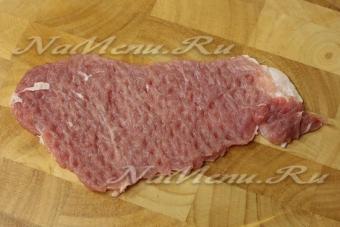(translated from Greek. circular) is a plane transcendental curve, which is described by a point of a circle of radius r rolling along a straight line without slipping (a transcendental curve is a curve that cannot be described in rectangular coordinates algebraic equation). Its parametric equation
x = rt – r sin t,
y= r - r cos t
The intersection points of the cycloid with the line along which the circle rolls (this circle is called generating, and the line along which it rolls is called the guide) are called cusp points, and the highest points on the cycloid, located in the middle between neighboring cusp points, are called the vertices of the cycloid.
Galileo Galilei was the first to study the cycloid. The length of one arch of the cycloid was determined in 1658 by the English architect and mathematician Christopher Wren, the author of the project and the builder of the dome of St. Paul's Cathedral in London. It turned out that the length of the cycloid is equal to 8 radii of the generating circle.
One of wonderful properties cycloid, which gave it its name - brachistochrone (from the Greek words "shortest" and "time") is associated with the solution of the problem of the steepest descent. The question arose of what shape should be given to a well-polished (to practically eliminate friction) chute connecting two points so that the ball rolls down from one point to another in shortest time. The Bernoulli brothers proved that the trough must have the shape of an inverted cycloid.
Curves related to the cycloid can be obtained by considering the trajectories of points that are not on the generating circle.
Let the point From 0 is inside the circle. If passed through From 0 auxiliary circle with the same center as the generating circle, then when the generating circle rolls along a straight line AB a small circle will roll in a straight line A´ IN´, but its rolling will be accompanied by sliding, and the point From 0 describes a curve called a shortened cycloid.
An elongated cycloid is defined in a similar way - this is the trajectory of a point located on the continuation of the radius of the generating circle, while rolling is accompanied by sliding in the opposite direction.
Cycloidal curves are used in many technical calculations and their properties are used, for example, in the construction of gear tooth profiles, in cycloidal pendulums, in optics, and thus the study of these curves is important from an applied point of view. No less important is the fact that, studying these curves and their properties, scientists of the 17th century. developed techniques that led to the creation of differential and integral calculus, and the problem of the brachistochrone was a step towards the invention of the calculus of variations.
Elena Malishevskaya
LEmniskates
Equation in polar coordinates:
r 2 = a 2 cos2θ
(x 2 + y 2) 2 = a 2 (x 2 - y 2)
Angle between AB" or A"B and the x-axis = 45 o
The area of one loop \u003d a 2 / 2
CYCLOID
Area of one arc = 3πa 2
Arc length of one arch = 8a
This is the curve described by the point P on a circle of radius a, which rolls along the x axis. 
HYPOCYCLOIDS WITH FOUR POINTS
Equation in rectangular coordinates:
x 2/3 + y 2/3 = a 2/3
Equations in parametric form: 
Area enclosed by curve = 3πa 2 /8
Whole curve arc length = 6a
This is a curve described by a point P on a circle of radius a/4, which rolls inside a circle of radius a. 
CARDIOID
Equation: r = a(1 + cosθ)
Area bounded by curve = 3πa 2 /2
Curve arc length = 8a
This is the curve described by the point P on a circle of radius a, which rolls outside the circle of radius a. This curve is also a special case of Pascal's snail. 
CHAIN LINE
The equation:
y = a(e x/a + e -x/a)/2 = acosh(x/a)
This is the curve that would be followed by a chain suspended vertically from point A to point B. 
THREE-PETAL ROSE
Equation: r = acos3θ
The equation r = acos3θ is like a curve obtained by rotating counterclockwise along a curve of 30 o or π/6 radians.
In general, r = acosnθ or r = asinnθ has n lobes if n is odd. 
FOUR-PETAL ROSE
Equation: r = acos2θ
The equation r = asin2θ is like a curve obtained by rotating counterclockwise along a 45o or π/4 radian curve.
In general, r = acosnθ or r = asinnθ has 2n petals if n is even. 
EPICYCLOID
Parametric equations: 
This is the curve described by a point P on a circle of radius b as it rolls along the outside of a circle of radius a. The cardioid is a special case of the epicycloid. 
GENERAL HYPOCYCLOID
Parametric equations: 
This is the curve described by a point P on a circle of radius b as it rolls along the outside of a circle of radius a.
If b = a/4, the curve is a hypocycloid with four cusps. 
Trochoid
Parametric equations: 
This is the curve described by a point P at a distance b from the center of a circle with radius a as it rolls along the x-axis.
If b is a shortened cycloid.
If b > a, the curve has the shape shown in fig. 11-11 and called trochod.
If b = a, the curve is a cycloid. 
TRAKTRICE
Parametric equations: 
This is the curve described by the end point P of a stretched string of length PQ when the other end Q moves along the x-axis. 
VERZIERA (VERZIERA) AGNESI (SOMETIMES AGNESIA CURLS)
Rectangular equation: y = 8a 3 /(x 2 + 4a 2)
Parametric equations: 
B. In the figure, a variable line OA intersecting y = 2a and a circle with radius a centered on (0,a) at A and B, respectively. Any point P on the "curl" is determined by constructing lines parallel to the x and y axes, and through B and A, respectively, and defining the intersection point P. 
Cartesian sheet
Equation in rectangular coordinates:
x 3 + y 3 = 3axy
Parametric equations: 
Loop area 3a 2 /2
Asymptote equation: x + y + a = 0. 
CIRCLE EVOLVENT
Parametric equations: 
This is the curve described by the end point P of the string as it unwinds from a circle of radius a. 
EVOLVENT ELLIPSE
Equation in rectangular coordinates:
(ax) 2/3 + (by) 2/3 = (a 2 - b 2) 2/3
Parametric equations: 
This curve is the envelope normal to the ellipse x 2 /a 2 + y 2 /b 2 = 1. 
OVALS OF CASINI
Polar equation: r 4 + a 4 - 2a 2 r 2 cos2θ = b 4 .
This is a curve described by a point P such that the product of its distance from two fixed points [distance 2a to the side] is a constant b 2 .
Curve as in the figures below when b a respectively.
If b = a, the curve is lemniscate
Pascal's snail
Polar equation: r = b + acosθ
Let OQ be a line joining the center O to any point Q on a circle of diameter a passing through O. Then the curve is the focus of all points P such that PQ = b.
The curve shown in the figures below when b > a or b 
CISSOID OF DIOCLE
Equation in rectangular coordinates: y 2 = x 3 /(2a - x)
Parametric equations: 
It is a curve described by a point P such that the distance OP = the distance RS. Used in task doubling cube, i.e. finding the side of a cube that has twice the volume of a given cube 
ARCHIMEDES SPIRAL
Polar equation: r = aθ 
Cyclomid (from the Greek KhklpaydYut - round) - a flat transcendental curve. A cycloid is defined kinematically as the trajectory of a fixed point of a generating circle of radius r rolling without slip along a straight line.
Equations
Let us take the horizontal coordinate axis as a straight line along which the generating circle of radius r rolls.
The cycloid is described by parametric equations
Equation in Cartesian coordinates:
The cycloid can be obtained as a solution to the differential equation:
Properties

- · Cycloid -- periodic function along the abscissa, with a period of 2pr. It is convenient to take singular points (customs points) of the form t = 2рk, where k is an arbitrary integer, as the boundaries of the period.
- · To draw a tangent to the cycloid at its arbitrary point A, it is enough to connect this point with the top point of the generating circle. Connecting A to the lowest point of the generating circle, we get the normal.
- · The length of the cycloid arch is 8r. This property was discovered by Christopher Wren (1658).
- · The area under each arch of the cycloid is three times larger than the area of the generating circle. Torricelli claims that this fact was discovered by Galileo.
- · The radius of curvature of the first arch of the cycloid is equal to.
- · An "inverted" cycloid is a curve of steepest descent (brachistochrone). Moreover, it also has the property of tautochronism: a heavy body placed at any point of the cycloid arc reaches the horizontal in the same time.
- · The oscillation period of a material point sliding along an inverted cycloid does not depend on the amplitude, this fact was used by Huygens to create an accurate mechanical watch.
- · The evolution of a cycloid is a cycloid that is congruent to the original one, namely, it is parallel shifted so that the vertices turn into “points”.
- Details of machines that perform simultaneously uniform rotational and forward movement, describe cycloid curves (cycloid, epicycloid, hypocycloid, trochoid, astroid) (cf. the construction of Bernoulli's lemniscate).
5. Parametric equation of the cycloid and the equation in Cartesian coordinates
Suppose we have a cycloid formed by a circle of radius a centered at point A.
If we choose as a parameter that determines the position of the point, the angle t=∟NDM, by which the radius, which had a vertical position AO at the beginning of the rolling, has managed to turn, then the x and y coordinates of the point M will be expressed as follows:
x \u003d OF \u003d ON - NF \u003d NM - MG \u003d at-a sin t,
y= FM = NG = ND - GD = a - a cos t
So the parametric equations of the cycloid have the form:

When changing t from -∞ to +∞, you get a curve consisting of an innumerable set of such branches, which is shown in this figure.
Also, in addition to the parametric equation of the cycloid, there is also its equation in Cartesian coordinates:
Where r is the radius of the circle forming the cycloid.
6. Problems for finding parts of a cycloid and figures formed by a cycloid
Task number 1. Find the area of a figure bounded by one arc of a cycloid whose equation is given parametrically
![]()
and axis Oh.

Solution. To solve this problem, we use the facts known to us from the theory of integrals, namely:
The area of the curvilinear sector.
Consider some function r = r(ϕ) defined on [α, β].
ϕ 0 ∈ [α, β] corresponds to r 0 = r(ϕ 0) and, therefore, the point M 0 (ϕ 0 , r 0), where ϕ 0 ,
r 0 - polar coordinates of the point. If ϕ changes, “running through” the whole [α, β], then the variable point M will describe some curve AB given by
the equation r = r(ϕ).
Definition 7.4. A curvilinear sector is a figure bounded by two rays ϕ = α, ϕ = β and a curve AB given in polar
coordinates by the equation r = r(ϕ), α ≤ ϕ ≤ β.
The following
Theorem. If the function r(ϕ) > 0 and is continuous on [α, β], then the area
curved sector is calculated by the formula:

This theorem was proved earlier in the topic of a definite integral.
Based on the above theorem, our problem of finding the area of a figure bounded by one arch of the cycloid, the equation of which is given by the parametric x= a (t - sin t) , y= a (1 - cos t) , and the Ox axis, is reduced to the following solution .
Solution. From the curve equation dx = a(1−cos t) dt. The first arch of the cycloid corresponds to the change in the parameter t from 0 to 2π. Consequently,

Task number 2. Find the length of one arc of the cycloid
![]()
The following theorem and its corollary were also studied in integral calculus.
Theorem. If the curve AB is given by the equation y = f(x), where f(x) and f ’ (x) are continuous on , then AB is rectifiable and
Consequence. Let AB be given parametrically
L AB = ![]() (1)
(1)
Let the functions x(t), y(t) be continuously differentiable on [α, β]. Then
formula (1) can be written as

Let's make a change of variables in this integral x = x(t), then y'(x)= ;
dx= x'(t)dt and hence:

Now let's get back to solving our problem.
Solution. We have and therefore
Task number 3. It is necessary to find the surface area S formed from the rotation of one arc of the cycloid
L=((x,y): x=a(t - sin t), y=a(1 - cost), 0≤ t ≤ 2π)
In integral calculus, there is the following formula for finding the surface area of a body of revolution around the x-axis of a curve defined parametrically on a segment: x=φ(t), y=ψ(t) (t 0 ≤t ≤t 1)
Applying this formula to our cycloid equation, we get:

Task number 4. Find the volume of the body obtained by rotating the arch of the cycloid
![]()
Along the axis Ox.
In integral calculus, when studying volumes, there is the following remark:
If the curve bounding the curvilinear trapezoid is given by parametric equations and the functions in these equations satisfy the conditions of the theorem on the change of variable in a certain integral, then the volume of the body of rotation of the trapezoid around the Ox axis will be calculated by the formula

Let's use this formula to find the volume we need.
Problem solved.
Conclusion
So, in the course of this work, the main properties of the cycloid were clarified. They also learned how to build a cycloid, found out the geometric meaning of the cycloid. As it turned out, the cycloid has a huge practical application not only in mathematics, but also in technological calculations, in physics. But the cycloid has other merits. It was used by scientists of the 17th century in developing methods for studying curved lines - those methods that eventually led to the invention of differential and integral calculus. It was also one of the "touchstones" on which Newton, Leibniz and their first researchers tested the power of powerful new mathematical methods. Finally, the problem of the brachistochrone led to the invention of the calculus of variations, which is so necessary for today's physicists. Thus, the cycloid was inextricably linked with one of the most interesting periods in the history of mathematics.
Literature
1. Berman G.N. Cycloid. - M., 1980
2. Verov S.G. Brachistochrone, or another secret of the cycloid // Kvant. - 1975. - No. 5
3. Verov S.G. Secrets of the cycloid// Kvant. - 1975. - No. 8.
4. Gavrilova R.M., Govorukhina A.A., Kartasheva L.V., Kostetskaya G.S., Radchenko T.N. Applications of a definite integral. Guidelines and individual assignments for 1st year students of the Faculty of Physics. - Rostov n / a: UPL RSU, 1994.
5. Gindikin S.G. Star age of a cycloid // Kvant. - 1985. - No. 6.
6. Fikhtengolts G.M. Course of differential and integral calculus. T.1. - M., 1969
Such a line is called an "envelope". Every curved line is the envelope of its tangents.
Matter and motion, and the method that they constitute, enable everyone to realize their potential in the knowledge of truth. The development of a methodology for the development of a dialectical-materialistic form of thinking and the mastery of a similar method of cognition is the second step towards solving the problem of development and realizing the possibilities of Man. Fragment XX Opportunities...
The situation can get sick with neurasthenia - neurosis, the basis clinical picture which constitutes the asthenic state. Both in the case of neurasthenia and in the case of decompensation of neurasthenic psychopathy, the essence of mental (psychological) protection is manifested by a departure from difficulties into irritable weakness with vegetative dysfunctions: either a person unconsciously “fights back” more from an attack ...





Various kinds activities; development of spatial imagination and spatial representations, figurative, spatial, logical, abstract thinking of schoolchildren; the formation of skills to apply geometric and graphic knowledge and skills to solve various applied problems; familiarization with the content and sequence of stages of project activities in the field of technical and ...
Arcs. Spirals are also involutes of closed curves, such as the involute of a circle. The names of some spirals are given by the similarity of their polar equations with the equations of curves in Cartesian coordinates, for example: parabolic spiral (a - r)2 = bj, hyperbolic spiral: r = a/j. Rod: r2 = a/j si-ci-spiral, whose parametric equations look like: , )





